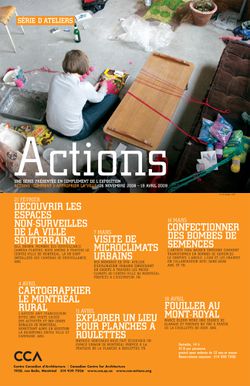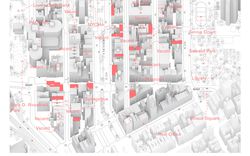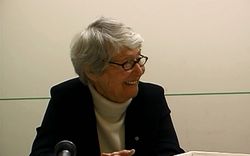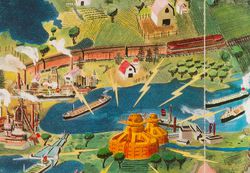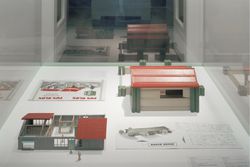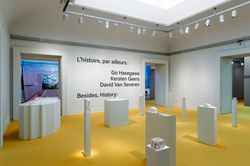Projet
AP075.S1.1961.PR01
Description:
This project series documents Cornelia Hahn Oberlander's landscape project for the Skeena Terrace Low Rent Housing Project, a housing development located on the eastern edge of Vancouver. Oberlander worked on this project between 1961 and 1965. The architectural firm in charge of the project was Underwood, McKinley, Cameron, Wilson & Smith Architects. The project was comprised of an eight-storey apartment tower and twenty-seven three-storey maisonettes. Oberlander was in charge of the landscape design for the twelve-acre site. The project initially included the construction of a roadway cutting the site in two, but was never built due to protests from the community. Oberlander's landscape plan included a design for an outdoor terrace and garden areas for the maisonnettes, a community garden and numerous recreational and social spaces. She also designed play scultpures for small children. The project series contains design development drawings, including landscape plans and planting plans, working drawings, including a site plan and planting plans, a specifications addendum, an invitation to the official inauguration of the project, and photographs, which are mostly of the construction site. Source: Herrington, Susan. Cornelia Hahn Oberlander: Making the Modern Landscape, University of Virginia Press, 2014, 304 pages.
1961-1965
Skeena Terrace Low Rent Housing, Vancouver, British Columbia (1961-1965)
Actions:
AP075.S1.1961.PR01
Description:
This project series documents Cornelia Hahn Oberlander's landscape project for the Skeena Terrace Low Rent Housing Project, a housing development located on the eastern edge of Vancouver. Oberlander worked on this project between 1961 and 1965. The architectural firm in charge of the project was Underwood, McKinley, Cameron, Wilson & Smith Architects. The project was comprised of an eight-storey apartment tower and twenty-seven three-storey maisonettes. Oberlander was in charge of the landscape design for the twelve-acre site. The project initially included the construction of a roadway cutting the site in two, but was never built due to protests from the community. Oberlander's landscape plan included a design for an outdoor terrace and garden areas for the maisonnettes, a community garden and numerous recreational and social spaces. She also designed play scultpures for small children. The project series contains design development drawings, including landscape plans and planting plans, working drawings, including a site plan and planting plans, a specifications addendum, an invitation to the official inauguration of the project, and photographs, which are mostly of the construction site. Source: Herrington, Susan. Cornelia Hahn Oberlander: Making the Modern Landscape, University of Virginia Press, 2014, 304 pages.
Project
1961-1965
Projet
AP075.S1.1958.PR02
Description:
This project series documents Cornelia Hahn Oberlander's landscape project for her own residence on Olympic street, in Vancouver. Known as the Tick-Tack-Toe House, the Oberlanders designed the residence themselves in 1958-1959, as well as later additions in 1966-1967. The residence is a two-storey house, with the main living area all on the second floor, while the entrance and a part of the utility core is on the ground level. For minimal maintenance and to provide a dry space to play during rainy days, the landscaping included a paved perimeter around the central core. The landscape design included a wall on the west side of the site and tree planting along Olympic Street to block the view and the noise from the street. The project series is made up predominantly of plans of the residence, such as elevations, sections, details and floor plans, and working drawings for the landscaping, including landscape plans, and elevations and details for the garden wall. The project is also documented through photographs of the garden, and exterior and interior views of the house itself. Source: Herrington, Susan. Cornelia Hahn Oberlander: Making the Modern Landscape, University of Virginia Press, 2014, 304 pages.
1958 and 1966-1967
Oberlander Residence (construction and addition), Vancouver, British Columbia (1958 -1967)
Actions:
AP075.S1.1958.PR02
Description:
This project series documents Cornelia Hahn Oberlander's landscape project for her own residence on Olympic street, in Vancouver. Known as the Tick-Tack-Toe House, the Oberlanders designed the residence themselves in 1958-1959, as well as later additions in 1966-1967. The residence is a two-storey house, with the main living area all on the second floor, while the entrance and a part of the utility core is on the ground level. For minimal maintenance and to provide a dry space to play during rainy days, the landscaping included a paved perimeter around the central core. The landscape design included a wall on the west side of the site and tree planting along Olympic Street to block the view and the noise from the street. The project series is made up predominantly of plans of the residence, such as elevations, sections, details and floor plans, and working drawings for the landscaping, including landscape plans, and elevations and details for the garden wall. The project is also documented through photographs of the garden, and exterior and interior views of the house itself. Source: Herrington, Susan. Cornelia Hahn Oberlander: Making the Modern Landscape, University of Virginia Press, 2014, 304 pages.
Project
1958 and 1966-1967
Projet
AP075.S1.2001.PR01
Description:
Project series documents Cornelia Hahn Oberlander's proposal for the landscape master plan of Alberta Children's Hospital in Calgary. Oberlander worked on this project in the early 2000s. Oberlander was in charged of developping the concept for the landscape master plan and create a healing garden. Her concept included a site entry with a strong presence of the nature to reassure the visitor, the use of native plants to keep the landscape of the hospital in harmony with site natural landscape, the use of plants that encourage and support wildlife to allow sick children to appreciate nature, outdoor seating areas and pathways with lighting to be used even at nightime, and environments for play and learning for sick children and their relatives. A participatory method was also applied for the design of the master plan throughout workshops organized with the children of the hospital in which they were invited to draw what they wanted for the healing garden. The project series contains landscape plans, site plans, landscape concept plans, site concept plans and presentation drawings. The project is also documented through Oberlander's concept notes, correspondence, including correspondence with client, Oberlander's landscape proposal, landscape concept presentation documents, financial documents, research material, and photographs of the site for the hospital.
2000-2004
Alberta Children's Hospital, Calgary, Alberta (2001)
Actions:
AP075.S1.2001.PR01
Description:
Project series documents Cornelia Hahn Oberlander's proposal for the landscape master plan of Alberta Children's Hospital in Calgary. Oberlander worked on this project in the early 2000s. Oberlander was in charged of developping the concept for the landscape master plan and create a healing garden. Her concept included a site entry with a strong presence of the nature to reassure the visitor, the use of native plants to keep the landscape of the hospital in harmony with site natural landscape, the use of plants that encourage and support wildlife to allow sick children to appreciate nature, outdoor seating areas and pathways with lighting to be used even at nightime, and environments for play and learning for sick children and their relatives. A participatory method was also applied for the design of the master plan throughout workshops organized with the children of the hospital in which they were invited to draw what they wanted for the healing garden. The project series contains landscape plans, site plans, landscape concept plans, site concept plans and presentation drawings. The project is also documented through Oberlander's concept notes, correspondence, including correspondence with client, Oberlander's landscape proposal, landscape concept presentation documents, financial documents, research material, and photographs of the site for the hospital.
Project
2000-2004
Bill Brown guide les participants à travers le Montréal souterrain, indiquant les lieux où se trouvent des caméras de surveillance et discutant de la place qu’occupe la surveillance dans l’espace public. Brown est membre des Surveillance Camera Players, un groupe new yorkais qui repère et répertorie les caméras de surveillance installées en milieu urbain. En complément de(...)
Complexe Desjardins
21 février 2009
Découvrir la ville souterraine sans surveillance
Actions:
Description:
Bill Brown guide les participants à travers le Montréal souterrain, indiquant les lieux où se trouvent des caméras de surveillance et discutant de la place qu’occupe la surveillance dans l’espace public. Brown est membre des Surveillance Camera Players, un groupe new yorkais qui repère et répertorie les caméras de surveillance installées en milieu urbain. En complément de(...)
Complexe Desjardins
articles
Du fait de sa simple existence, le commerce de détail est civique et politique
Entretien de Jack Self avec Hilary Sample sur la façon dont les architectes peuvent répondre aux nouvelles dynamiques urbaines du commerce en détail
Actions:
articles
9 janvier 2023
articles
L'esprit de Cornelia
Cornelia Hahn Oberlander, Martien de Vletter, paysage, terrain de jeux, Robson Square, toits verts, jardin, environnement
25 mai 2021
Joignez-vous à nous à Toronto pour une conversation entre Naomi Klein, auteur et activiste, et Mirko Zardini, directeur du CCA, qui portera sur les perspectives tendues et conflictuelles de ce que l’on appelle « l’environnement naturel ». Quel rôle joueront les architectes, les architectes de paysage, les urbanistes, les artistes et les activistes dans l’effort de trouver(...)
John H. Daniels Faculty of Architecture, Landscape, and Design, University of Toronto
17 octobre 2016, 18h30
What Comes After the Environment?
Actions:
Description:
Joignez-vous à nous à Toronto pour une conversation entre Naomi Klein, auteur et activiste, et Mirko Zardini, directeur du CCA, qui portera sur les perspectives tendues et conflictuelles de ce que l’on appelle « l’environnement naturel ». Quel rôle joueront les architectes, les architectes de paysage, les urbanistes, les artistes et les activistes dans l’effort de trouver(...)
John H. Daniels Faculty of Architecture, Landscape, and Design, University of Toronto
documents textuels
Quantité:
13 file
Article drafts
ARCH241898
Description:
Hays Introduction - drafts by Michael Hays Deamer - drafts of article by Peggy Deamer Kwinter - article drafts by Sanford Kwinter Robbins, Ed - article drafts by Edward Robbins El-Dahdah love letter from Plano - drafts of play by Farès el-Dahdah El-Dahdah Images Rostislav Svácha - Letter from Prague Allen - drafts of article by Stan Allen Graf - drafts of article by Doug Graf Hildner - drafts of article by Jeffrey Hildner Greg Lynn - drafts of article by Greg Lynn Gwathmey Singapore / California House Gwathmey Interview - Charles Gwathmey interviewed by Cynthia Davidson (transcripts)
1994-1995
Article drafts
Actions:
ARCH241898
Description:
Hays Introduction - drafts by Michael Hays Deamer - drafts of article by Peggy Deamer Kwinter - article drafts by Sanford Kwinter Robbins, Ed - article drafts by Edward Robbins El-Dahdah love letter from Plano - drafts of play by Farès el-Dahdah El-Dahdah Images Rostislav Svácha - Letter from Prague Allen - drafts of article by Stan Allen Graf - drafts of article by Doug Graf Hildner - drafts of article by Jeffrey Hildner Greg Lynn - drafts of article by Greg Lynn Gwathmey Singapore / California House Gwathmey Interview - Charles Gwathmey interviewed by Cynthia Davidson (transcripts)
documents textuels
Quantité:
13 file
1994-1995
À partir de jeux et de jouets d’architecture choisis dans la collection du CCA, y compris 33 jouets d’architecture nord-américains et européens datant du début du XIXe siècle jusqu’à 1995, Maisons de rêve, maisons jouets examine les notions de domicile, d’enfance, de jeu, d’apprentissage et de rôle déterminé selon le sexe. Cette exposition montre comment les jouets(...)
Maisons de rêve, maisons jouets
Actions:
Description:
À partir de jeux et de jouets d’architecture choisis dans la collection du CCA, y compris 33 jouets d’architecture nord-américains et européens datant du début du XIXe siècle jusqu’à 1995, Maisons de rêve, maisons jouets examine les notions de domicile, d’enfance, de jeu, d’apprentissage et de rôle déterminé selon le sexe. Cette exposition montre comment les jouets(...)
Quel rôle l’histoire a-t-elle à jouer dans la pratique architecturale contemporaine? Plutôt que d’adopter une position postmoderne ou d’évoquer des débats anciens et des formes architecturales historiques, Go Hasegawa, Kersten Geers et David Van Severen abordent dans leur travail les problématiques actuelles dans un esprit de dialogue avec l’histoire. Même si les(...)
Salles principales Mot(s)-clé(s):
L’histoire, par ailleurs, Go Hasegawa, Kersten Geers, David Van Severen, Office, KGDVS, Bas Princen
10 mai 2017 au 15 octobre 2017
L’histoire, par ailleurs : Go Hasegawa, Kersten Geers, David Van Severen
Actions:
Description:
Quel rôle l’histoire a-t-elle à jouer dans la pratique architecturale contemporaine? Plutôt que d’adopter une position postmoderne ou d’évoquer des débats anciens et des formes architecturales historiques, Go Hasegawa, Kersten Geers et David Van Severen abordent dans leur travail les problématiques actuelles dans un esprit de dialogue avec l’histoire. Même si les(...)
Salles principales Mot(s)-clé(s):
L’histoire, par ailleurs, Go Hasegawa, Kersten Geers, David Van Severen, Office, KGDVS, Bas Princen
